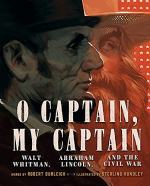
|
| Name: _________________________ | Period: ___________________ |
This test consists of 15 multiple choice questions and 5 short answer questions.
Multiple Choice Questions
1. What does the phrase "swaying mass" refer to (line 12)?
(a) The crowd.
(b) The ship.
(c) The flag.
(d) The captain.
2. What is the most common type of metrical foot in "O Captain! My Captain!"?
(a) The spondee.
(b) The trochee.
(c) The iamb.
(d) The dactyl.
3. Which technique is evident in line 10, "Rise up—for you the flag is flung—for you the bugle trills"?
(a) Anaphora.
(b) Antistrophe.
(c) Antimetabole.
(d) Antithesis.
4. What is the rhyme pattern of the first four lines of each stanza?
(a) AABB.
(b) ABAC.
(c) ABCB.
(d) ABBA.
5. What feature of the Captain's face does line 17 focus on?
(a) His chin.
(b) His eyes.
(c) His mouth.
(d) His brow.
6. Line 5, " But O heart! heart! heart!" is an example of which technique?
(a) Euphemism.
(b) Apostrophe.
(c) Aphorism.
(d) Paradox.
7. Line 4, "While follow eyes the steady keel, the vessel grim and daring," contains examples of which techniques?
(a) Synecdoche and personification.
(b) Personification and simile.
(c) Alliteration and synecdoche.
(d) Simie and alliteration.
8. Which details in the second stanza evoke a patriotic occasion?
(a) The crowd and the shore.
(b) The flag and bugle.
(c) The bouquets and wreaths.
(d) The captain and the bells.
9. What is the most accurate way to describe the poem's stanza form?
(a) Double tercet.
(b) Octave.
(c) Sestet.
(d) Double quatrain.
10. In the second quatrain of the second stanza, what becomes clear about the speaker's state of mind?
(a) He is actually asleep and only dreaming of the captain's death.
(b) He has not fully accepted the captain's death.
(c) He hopes to hide the captain's death from the crowd.
(d) He is afraid that he is in some way responsible for the captain's death.
11. Who is the speaker of the poem?
(a) A soldier.
(b) A writer.
(c) A sailor.
(d) A doctor.
12. What does it mean that the people are "exulting"?
(a) They are drinking and celebrating.
(b) They are cheering excitedly.
(c) They are crying out in grief.
(d) They are quietly watchful.
13. The list of ways the crowd is celebrating the arrival of the ship in lines 9-12 is an example of which technique?
(a) Understatement.
(b) Paraprosdokian.
(c) Periphrasis.
(d) Accumulation.
14. By which other term, besides "Captain," does the speaker address the captain of the ship?
(a) Father.
(b) Leader.
(c) Master.
(d) Brother.
15. Which technique is evident in the phrase "for you the flag is flung" (line 10)?
(a) Assonance.
(b) Cacophony.
(c) Sibilance.
(d) Alliteration.
Short Answer Questions
1. What is a "keel" (line 4)?
2. In context, the literal meaning of the word "rack" in line two is which of the following?
3. Who is the author of "O Captain! my Captain!"?
4. Which term describes the poem's repeated use of the phrases "O Captain! My Captain!" (lines 1 and 9) and "fallen cold and dead" (lines 8, 16, and 24)?
5. Line 6, "O the bleeding drops of red," is an example of which technique?
|
This section contains 503 words (approx. 2 pages at 300 words per page) |

|




